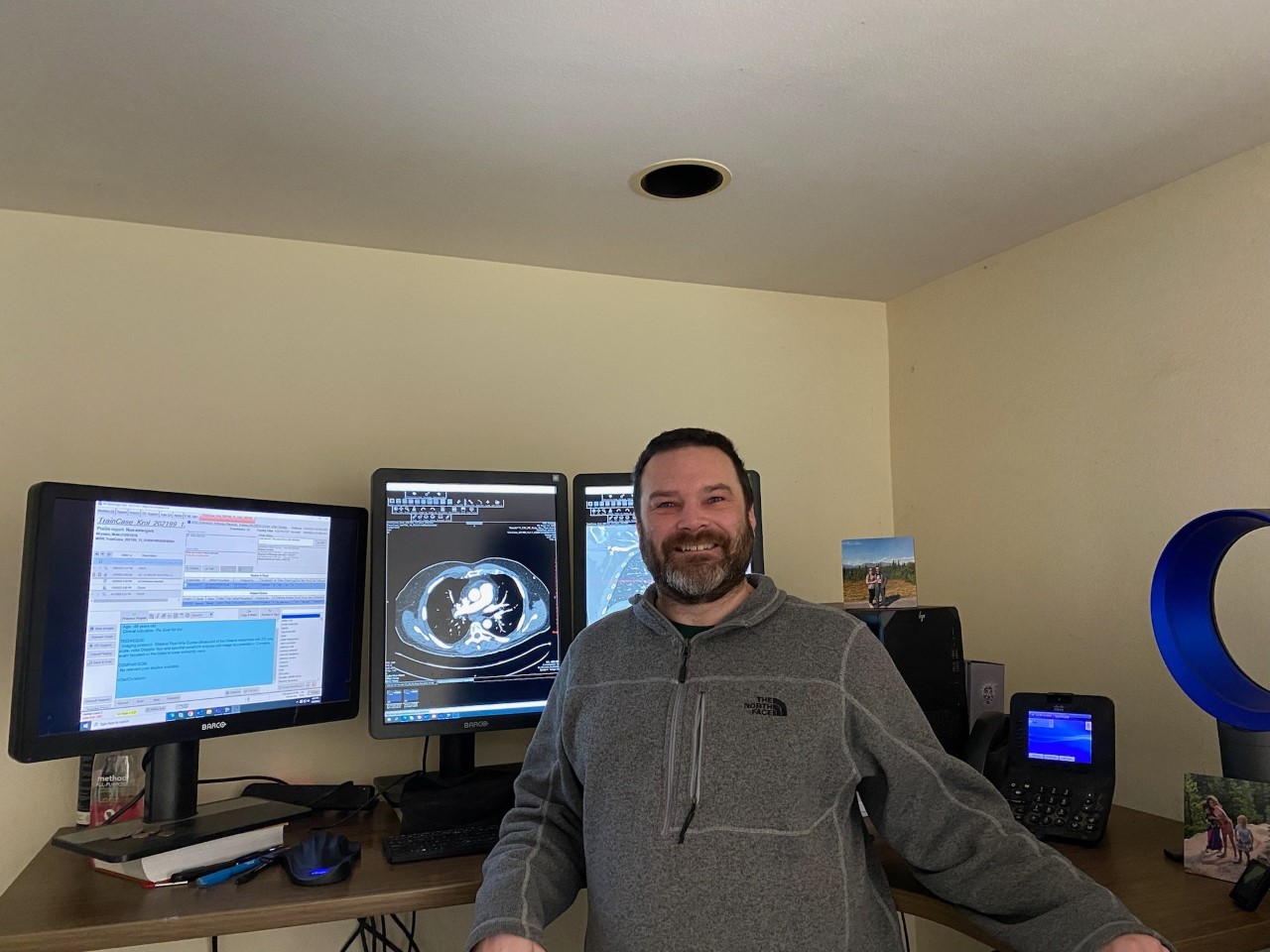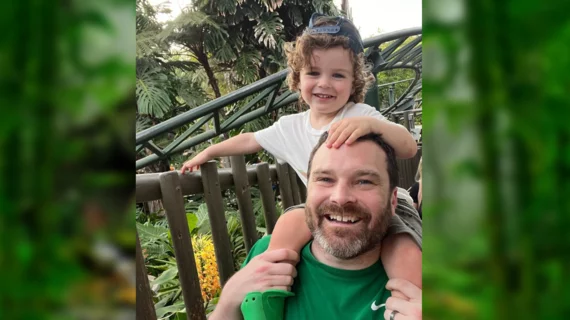I didn’t plan to start in teleradiology after my radiology residency—but I’m glad I did
I’ll be honest, I had no plans to go into teleradiology straight from residency. However, I fell into it because economic conditions meant choices were slim as I started my career in 2014. It was just a few years after the stock market crashed and many older radiologists had decided to postpone retirement as they saw their retirement savings diminish. That meant that the job market was hypercompetitive; hospital groups and private practices simply weren’t hiring. I also was in the process of moving from the Midwest to the West Coast, where I didn’t have much of a professional network. For these reasons and more, teleradiology made so much sense. Eight years later, it still does.
I can say with 100% certainty that working in remote radiology is the best thing that ever happened to me. It’s given me freedom, flexibility, and time with my family that I never could have found otherwise—along with a very rewarding and meaningful career. I’m really glad I didn’t wait until I was ready to retire to give it a try.
Here are just a few ways that working in teleradiology has changed my life for the better, and why I’d encourage radiologists in residency and fellowship to strongly consider reading remotely instead of going down the traditional career path.
Work-life balance—right from the start
In more traditional paths, whether that’s private practice, academia or hospital groups, flexibility—especially for new radiologists—is less likely. That is the reality of on-site 24/7 medicine. Groups have obligations to offer care, all the time. And depending on the size of the practice and its culture, those with less seniority will likely end up with the least desirable shifts and the most pressure to not rock the boat.
Need to leave the office to handle a family emergency? Want to take time off to make your kid’s game or attend a holiday dinner? Or simply take a break? The answer is often “no” in your early years.
My experience with teleradiology at vRad isn’t like that, now or when I started. It doesn’t matter how junior or senior you are; the practice is large and there’s enough coverage that you can plan for that time off or step out when you need to knowing those patients on the list will be taken care of by one of the many radiologists on shift.
Not long ago, I needed to pick up my daughter unexpectedly. All I had to do was tell the Operations Center that I needed to go, and that was it—they always encourage you to take care of your family.
Recently, I had an opportunity to see Elton John’s 50th Anniversary concert at Dodgers Stadium, but—oh, no!—I was scheduled to work that Thursday. I emailed scheduling and asked if I could swap a different day. They made sure we had adequate coverage and put me on a Monday shift instead. (The concert was amazing, by the way.) Longer term time off is flexible as well. In 2018, I wanted to get out and have an adventure—so I went to South Africa and Zimbabwe, where I went on safari (also amazing!).
Young radiologists can benefit so much from better balance. Find a practice that lets you enjoy your youth and tick off those bucket list items that build your happiness!
The ability to live anywhere
A major consideration for many radiologists finishing up a residency or fellowship is where that first job will land you. Do you want to stay in the city you are in? Move closer to friends or family? What practices are hiring, and do you want to work there? Or perhaps you don’t know exactly where you want to end up—or dread the idea of having to move for the job.
I would urge you not to think of teleradiology as a last resort. Remote radiology gives you the flexibility to be wherever it is you want to be—without sacrificing your personal or professional situation.

No worklist pressure, no burnout
Let me make one thing clear, burnout and pressure are not unique to traditional practice and radiologists working at teleradiology practices are not immune. That said, one thing I love about practicing teleradiology at vRad is that I feel like I’ve totally skipped the stress that many radiologists feel from worklist pressure, and the burnout that comes with it. I’ve never experienced the pressure to read faster, I don’t get called in or have work after I was supposed to go home. And I’ve never had to worry about attending pointless meetings or sit on boards while patients wait on my worklist.
As a young radiologist starting out my career, I really valued (and still do) the ability to take my time on a case if I need to. That’s something at a traditional practice I might have to sacrifice. And because I’m not a robot, it’s okay that some days I read a little slower than normal. There has never been anyone looking over my shoulder or asking why I’m not on that next case. Without having to fret about productivity floors or getting every case off my list before I go home, I can fully focus on getting to the right conclusion for the patient.
You’re never alone
It’s easy to worry about doing teleradiology right out of residency because none of us want to feel like we’re “alone,” with no one to confer on difficult cases with. Rest assured, you’re never alone at vRad. When I’m working, I typically have more than 100 people I can ask for help at any given time, including just about every type of specialist you can think of – all just a few clicks away.
There is no way I would ever have that kind of support outside of vRad – which is why it’s important to do your research before joining a practice. Ask questions about the consult process and how many radiologists are on during a shift. Depending on the size of the practice, you could be the only one, or not have access to subspecialties for a consult. Or your colleagues may not be as willing to help you with a case because they are worried about getting through their own list.
Staying put in remote radiology
My job with vRad offers me so many benefits that I can’t ever imagine leaving. I’m grateful that I stumbled upon this career and this lifestyle early enough to fully enjoy its benefits. I think it’s a big mistake when young radiologists write off teleradiology as a “last resort” or as something that’s only for older radiologists on their way to retirement. I can say from experience that vRad a great place to get started, because when life happens your career needs to be able to adjust to it. When I reach a point where I want to scale back my hours, I can do that here. Or if I want to read more to make more money for that upcoming trip or big purchase, I can do that too. And no matter what, I can always focus on quality of care, not just quantity.
These are all benefits I wish I knew about teleradiology in general, and vRad in particular. As luck would have it, I made the best choice first. But I want other residents and early career radiologists to know about the advantages teleradiology uniquely brings, and how vRad stands out in the world of teleradiology.
Want to hear more about what's it's like to work at vRad?
Join me and fellow vRad radiologist Dr. Teresa McQueen — who also joined vRad after residency — at our upcoming Virtual Open House for residents and fellows on Thursday, Dec. 15. You’ll also have a chance to ask questions during the live Q&A. Learn more and sign up today to register or for a link to the recording.
Let’s chat
As you’re evaluating the best practice to join when starting your career, I hope you consider vRad. If you’d like to speak to me directly, please request to be contacted here and mention my name. I’d be happy to share my experience and answer your questions.
